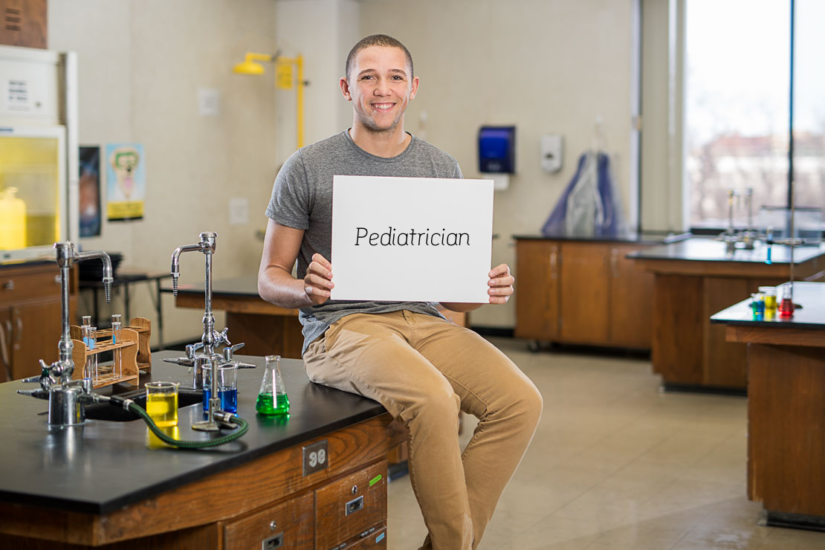
Where the Jobs Are
Today, young Central Minnesotans don’t need to leave the region to find fulfilling careers. The key is to help them realize there’s a world of opportunity close to home.
By Andy Steiner | Photography by John Linn
Lucas Bollig wasn’t sure what to expect when he showed up for a job interview at Pequot Tool and Manufacturing. He knew the company specialized in machining and fabrication, so he figured it would look and feel just the way he imagined any factory would look and feel.
“The truth is,” said the Brainerd-born-and-raised Bollig, “I’d never been in a factory. I expected a grungy atmosphere. I thought it would be like working in a mine or in another dirty place. I never expected it to be like this.”
When he says, ‘like this,” Bollig describes something “very clean and bright and not noisy at all.”
That one visit to a manufacturing facility shattered Bollig’s stereotypes about the industry. Today, in his job as a manufacturing engineer at Pequot Tool, Bollig, now three years in with a couple of promotions under his belt, wears regular street clothes to work. He has his own cubicle, computer, phone and voicemail. The only safety gear required? Steel-toed boots.
Breaking down perceptions about manufacturing jobs is one important step toward encouraging more young Central Minnesota residents like Bollig to take another look at the career opportunities that are plentiful in the region. As a growing economy collides with a shrinking labor force, Central Minnesota needs to come up with ways to help young people in the region understand that they don’t need to leave home to find a good job, said Don Hickman, Initiative Foundation vice president for community and workforce development.
“A lot of kids don’t know that great opportunities exist right here,” Hickman said. “Say you’ve gone to school in your hometown your whole life. You’ve always seen that big building down the road, but you don’t know that they’re a company that employs 200 people with good benefits and good wages. Most kids think that they have to move to a big city to get a good job, but that’s not the case anymore.”
Now Hiring
The most plentiful and highest-paying jobs in Central Minnesota include healthcare, information technology and skilled manufacturing, said Adam O’Doherty, executive director of Partner for Student Success, a collaboration of Greater St. Cloud-area school districts, businesses, community agencies, educational institutions and government dedicated to preparing students for career success.
“The workforce in the local manufacturing industry is aging out,” O’Doherty said. “So there are many jobs available there.” The region’s aging population also means that healthcare jobs are plentiful.
In fact, with record numbers of Baby Boomers retiring and new businesses popping up overnight, skilled workers are at a premium, Hickman said. “Earlier this year, a local manufacturing firm went out of business in one of our counties,”
Hickman recalls. “They laid off 150 people. That very afternoon I got a call from an economic development person in an adjacent county. She said, ‘I can help every one of those people find work. Can you help me make a connection?’ So I called the local EDA person, and she said, ‘There’s a purchase agreement pending, but the skilled workers are one of the key assets … they’re not going anywhere!’”

Degrees of Skill
One roadblock that’s likely intensifying the gap between available jobs and available workers in Central Minnesota is the broadly accepted idea that in order to land the very best positions, every young American high school graduate should go on to college and earn a four-year degree.
But that’s not necessarily the case, said Mike Schmidt, principal of Staples-Motley High School.
“A few years ago, it became the trendy thing to say, ‘America is going to send every kid to college,’” Schmidt said. “The reality turned out to be a bit of a false prophecy. Right now, the information technology and manufacturing sectors are exploding. These jobs don’t usually require four years of education and jobs are going unfilled.”
Furthermore, many jobs that require two years or less of post-secondary education offer wages and benefits that are competitive with those earned by some college graduates, said Tammy Biery, director of the Stearns-Benton Employment and Training Council. For many young people, she said, fewer years in college means lower debt loads.
“You can get a two-year degree in manufacturing and quickly move into a living-wage job making $40,000 a year or better with benefits,” Hickman said. “But programs for that skill are going unfilled. Part of it is an old stigma about the manufacturing sector. Many parents still have a perception that is almost two generations old—that manufacturing work is dirty, dangerous and doesn’t have options for advancement—but in reality it is now a high-tech and rapidly growing sector of the economy, particularly in Central Minnesota.”
Bollig, who earned a combined four-year degree in robotics and automated systems from Central Lakes College and Bemidji State University, said that his degree made him a highly attractive hire at Pequot Tool. But he also knows that the company makes a practice of training new employees and promoting from within.
In fact, degrees aren’t always the key to success in manufacturing careers, said Twyla Flaws, personnel manager at Clow Stamping, a 400-employee-strong metal stamping and fabricating firm based in Merrifield.
“To get ahead in this industry, you have to couple an education with a little common sense and the ability to problem solve,” said Flaws. Her company prefers to hire for character over education, she said, and train and promote from within.
With perspectives like that in mind, Schmidt said he and his colleagues at Staples-Motley High are focused on developing the whole student, looking beyond traditional post-secondary educational expectations and expanding graduates’ perspectives on what it takes to land their dream job.
“When we talk post-secondary at our school,” Schmidt said, “that means anything from immediately going into the workforce, to a certification program, to a two-year program or a four-year program or even prepping kids for going into a paid apprenticeship.” Through daily interactions with teachers and administrators and in-class discussions, Staples-Motley is helping students “develop the soft skills they need to get hired.”
Schmidt said the school also partners with Bridges Career Academies & Workplace Connection to participate in Minnesota ProStart, a program of the National Restaurant Association Education Foundation that exposes students to experiences in the hospitality industry. At Staples-Motley, students can take classes led by regional hospitality professionals, preparing them for jobs in a vibrant industry.
Matt Kilian, Brainerd Lakes Chamber president, explained that ProStart offers practical training for good-paying local jobs.
“You hear a lot about how schools and businesses should work together to bring learning to life,” he said. “That’s exactly what we’re doing. The ProStart program brings chefs into the classroom and students into the kitchens. Our hope is that some of these kids will become our next chefs, managers and entrepreneurs.”

Spreading the Word
Encouraging young people to consider job opportunities closer to home takes creativity and commitment, said Tim Walker, employee development coordinator at Pequot Tool, whose outreach efforts include presentations at high schools and community colleges and an annual robotics competition that’s held in Duluth and co-sponsored by Pequot Tool.
Walker also organized a group of local manufacturers to pool their money and purchase a miniaturized version of a computer numeric control (CNC) milling machine, a high-tech tool that’s used in many local manufacturing firms. This mini-CNC can be brought to high schools for students to give it a try.
He’s also deeply involved with the annual Bridges Career Day that’s held at Central Lakes College in Brainerd each spring, where some 2,000 students from area high schools come to learn about post-secondary education options, local employers and career opportunities, from healthcare, to law enforcement to the Department of Natural Resources.
In St. Cloud, the Greater St. Cloud Development Corporation and the Central Minnesota Manufacturing Association joined forces to develop a “Tour of Manufacturing,” where high school students and their families get to visit local employers.
Another innovative option for career exploration in Central Minnesota is Scrubs Camps, a three-day opportunity for high school and middle school students to explore healthcare and human services jobs. Through partnerships with local employers Rejuv Medical, CentraCare Health and The Good Shepherd Community, campers experience what it is like to work in these high-demand fields.
As far as Lucas Bollig is concerned, he knows his happy landing at Pequot Tool was a twist of fate, but he’s now committed to letting others know about the possibility of finding a good job in your backyard.
“I grew up here,” Bollig said. “I love the area. I feel lucky that I found a job right here that’s challenging and satisfying. I’d recommend this work to just about anyone.”
Career Resources for Young People
CAREER SOLUTIONS, ST. CLOUD
Provides job seekers with tools and resources; career counseling and assessment; and in some instances, financial assistance for training. careersolutionsjobs.org
CENTRAL MINNESOTA JOBS AND TRAINING SERVICES, INC., MONTICELLO
Matches job seekers, youth, businesses and those seeking training with available resources. cmjts.org
RURAL MINNESOTA CONCENTRATED EMPLOYMENT PROGRAM (CEP), BRAINERD
Offers employee and employer services to align careers and develop workforce skills. rmcep.com
BRIDGES CAREER ACADEMIES & WORKPLACE CONNECTION
Offers high school students opportunities to get involved in the workplace through invaluable hands-on learning experiences. bridgesconnection.org